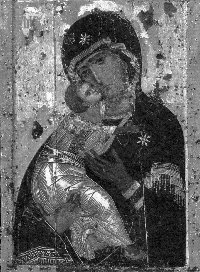Lucky Fate Of the Vyshhorod Mother of God

Maintaining contacts and friendly relations with various countries and cities in order to extend their influence and the Christian religion, the Byzantine emperors sent Greek metropolitans, bishops, clerks, architects, painters, and craftsmen. It was from that empire that Kyiv Rus received a religious art developed over the preceding centuries and brought to perfection according to the standards of those days. In Kyiv, Byzantine architects and painters set up workshops and studios. Aided by Ukrainian pupils, they decorated several churches with mosaics and frescoes.
Icon painting quickly developed on a par with mosaics and frescoes. The Tithe Church, embellished with frescoes and icons brought from the Byzantine Empire was the first monumental religious structure in Kyivan Rus. Before long Kyiv craftsmen created their own system of artistic values, which would for many years outline the road of Ukrainian art, fostering the development of Ukrainian schools of art. One of their excellent icons, known as The Great Panagea, is attributed by researchers to the Kyiv school which is another evidence that in the twelfth and thirteenth centuries, Kyiv was the venue of icon painting in Rus. While we can still see some of the frescoes and mosaic fragments dating from that period (e.g., at St. Sophia's Cathedral in Kyiv), very few early twelfth century icons made have survived the ravages of time.
In this sense the one portraying the Mother of God of Vyshhorod is lucky. Considered the most sacred icon of Kyiv Rus, having united thousands in one fraternal creed and love, it has reached our day, although losing its original appearance. The Orthodox Church dates it to the first century, claiming it was painted by the Apostle Luke, an unmatched painter of Her images.
In 1136, the icon was sent from Constantinople to Kyiv as a gift. Kyiv Prince Yuri Dolgoruky had it installed in Vyshhorod near Kyiv. Hence the icon's current title.
At the time Vyshhorod was a favorite princely retreat as the rulers of Kyiv Rus could not but appreciate the scenery, and they could feel safe there. In addition, Vyshhorod was sought by pilgrims after the first Rus princes Borys and Hlib, treacherously killed by Sviatopolk the Accursed and later canonized, were buried there. However, the icon did not remain there long. Rus princes continued to fighting for the Kyiv throne. Sometimes several princes would rule the city within a single year, each claiming precedence in the Rurik dynasty. In 1156, Vladimir Suzdal Prince Andrei Bogoliubsky, son of Yuri Dolgoruky, raided Kyiv and destroyed part of the city, stealing the icon and taking it to his capital of Vladimir on Kliazma. Alas, this icon, like so many cultural values taken away from Ukraine by that prince's descendants, will never return home.
In 1237, Suzdal, Vladimir, and Riazan were laid waste by Khan Batu Khan. The Mongols took with them the icon's frame. 150 years later, the icon was again vandalized by Khan Toktamysh. In 1395, it was transferred to the Dormition Cathedral in the Moscow Kremlin and later returned to Vladimir where it would stay for almost a century. In 1480, it was again taken to Moscow. In 1930, it turned up at the State History Museum, later at the Tretiakov Gallery. The icon is still there, called The Mother of God of Vladimir. In 1998, thousands of adherents could admire it and pray before it at the Dormition Cathedral on the day commemorating the Mother of God of Vladimir, a holiday instituted in 1480.
Painted on a lime board, the Vyshhorod Mother of God from Vyshhorod
was originally sized 78 x 55 cm. Restoration records from 1918 testify
that it was painted over several times, leaving intact only St. Mary's
and the Infant's faces. Experts date the latter to the early twelfth century.
One theory has it that Volyn-born Andrei Rubliov (creator of the famous
Holy Trinity), was among the painters entrusted with restoration
in the early fifteenth century.
Newspaper output №:
№22, (1999)Section
Culture





